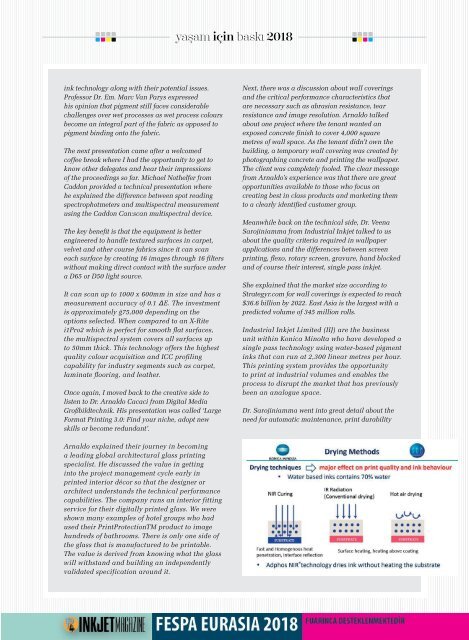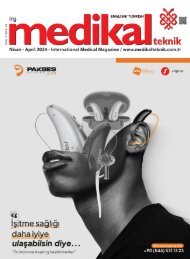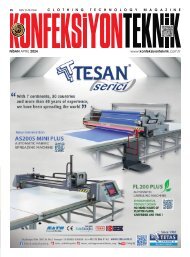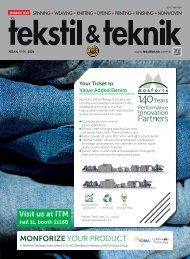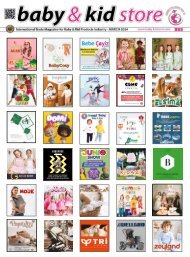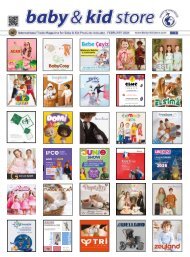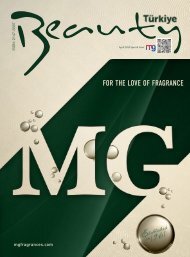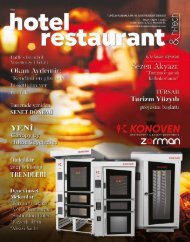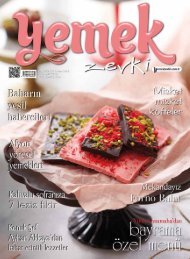You also want an ePaper? Increase the reach of your titles
YUMPU automatically turns print PDFs into web optimized ePapers that Google loves.
yaşam için baskı <strong>2018</strong><br />
ink technology along with their potential issues.<br />
Professor Dr. Em. Marc Van Parys expressed<br />
his opinion that pigment still faces considerable<br />
challenges over wet processes as wet process colours<br />
become an integral part of the fabric as opposed to<br />
pigment binding onto the fabric.<br />
The next presentation came after a welcomed<br />
coffee break where I had the opportunity to get to<br />
know other delegates and hear their impressions<br />
of the proceedings so far. Michael Nothelfer from<br />
Caddon provided a technical presentation where<br />
he explained the difference between spot reading<br />
spectrophotmeters and multispectral measurement<br />
using the Caddon Can:scan multispectral device.<br />
The key benefit is that the equipment is better<br />
engineered to handle textured surfaces in carpet,<br />
velvet and other course fabrics since it can scan<br />
each surface by creating 16 images through 16 filters<br />
without making direct contact with the surface under<br />
a D65 or D50 light source.<br />
It can scan up to 1000 x 600mm in size and has a<br />
measurement accuracy of 0.1 ΔE. The investment<br />
is approximately €75,000 depending on the<br />
options selected. When compared to an X-Rite<br />
i1Pro2 which is perfect for smooth flat surfaces,<br />
the multispectral system covers all surfaces up<br />
to 50mm thick. This technology offers the highest<br />
quality colour acquisition and ICC profiling<br />
capability for industry segments such as carpet,<br />
laminate flooring, and leather.<br />
Once again, I moved back to the creative side to<br />
listen to Dr. Arnaldo Cacaci from Digital Media<br />
Großbildtechnik. His presentation was called ‘Large<br />
Format Printing 3.0: Find your niche, adopt new<br />
skills or become redundant’.<br />
Next, there was a discussion about wall coverings<br />
and the critical performance characteristics that<br />
are necessary such as abrasion resistance, tear<br />
resistance and image resolution. Arnaldo talked<br />
about one project where the tenant wanted an<br />
exposed concrete finish to cover 4,000 square<br />
metres of wall space. As the tenant didn’t own the<br />
building, a temporary wall covering was created by<br />
photographing concrete and printing the wallpaper.<br />
The client was completely fooled. The clear message<br />
from Arnaldo’s experience was that there are great<br />
opportunities available to those who focus on<br />
creating best in class products and marketing them<br />
to a clearly identified customer group.<br />
Meanwhile back on the technical side, Dr. Veena<br />
Sarojiniamma from Industrial Inkjet talked to us<br />
about the quality criteria required in wallpaper<br />
applications and the differences between screen<br />
printing, flexo, rotary screen, gravure, hand blocked<br />
and of course their interest, single pass inkjet.<br />
She explained that the market size according to<br />
Strategyr.com for wall coverings is expected to reach<br />
$36.6 billion by 2022. East Asia is the largest with a<br />
predicted volume of 345 million rolls.<br />
Industrial Inkjet Limited (IIJ) are the business<br />
unit within Konica Minolta who have developed a<br />
single pass technology using water-based pigment<br />
inks that can run at 2,300 linear metres per hour.<br />
This printing system provides the opportunity<br />
to print at industrial volumes and enables the<br />
process to disrupt the market that has previously<br />
been an analogue space.<br />
Dr. Sarojiniamma went into great detail about the<br />
need for automatic maintenance, print durability<br />
Arnaldo explained their journey in becoming<br />
a leading global architectural glass printing<br />
specialist. He discussed the value in getting<br />
into the project management cycle early in<br />
printed interior décor so that the designer or<br />
architect understands the technical performance<br />
capabilities. The company runs an interior fitting<br />
service for their digitally printed glass. We were<br />
shown many examples of hotel groups who had<br />
used their PrintProtectionTM product to image<br />
hundreds of bathrooms. There is only one side of<br />
the glass that is manufactured to be printable.<br />
The value is derived from knowing what the glass<br />
will withstand and building an independently<br />
validated specification around it.


